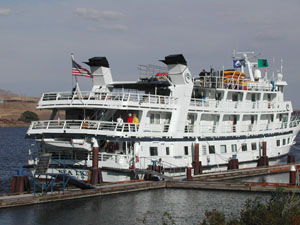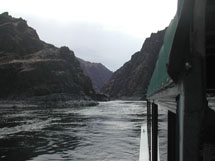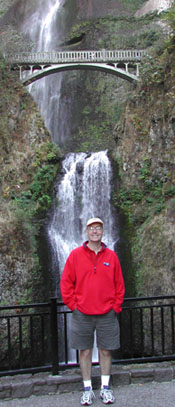In the Wake of Lewis and Clark
Last fall, the Association of Emory Alumni Travel Program offered an adventurous sailing excursion that traced the latter part of the grueling passage braved by famed explorers Meriwether Lewis and William Clark. History Professor Patrick Allitt joined the group and offered fellow passengers his keen historical insight along the way. Upon his return, Professor Allitt agreed to share an account of this fascinating journey with Emory Magazine. The ship Sea Lion left Portland, Oregon, on September 22, 2005, carrying sixty passengers, half of whom were Emory alumni. Over the next six days we sailed the Columbia and Snake rivers, following the last part of the transcontinental route Lewis and Clark had taken back in 1805. They had crossed the continent on behalf of President Jefferson, exploring the new Louisiana Purchase and looking for an easy river route to the Pacific.
Who do you suppose had more fun: the original travelers or we latter day pilgrims? Consider: Lewis and Clark took three years for their journey. For us it was a matter of one week. They endured periods of near-starvation and had to cross the Rocky and Bitterroot mountains in heavy snow, underdressed and poorly shod, sleeping on the ground, menaced by bears, and always afraid of Indian attacks. We slept in comfortable beds, wore stout shoes, and ate three hearty meals a day cooked by a Cordon Bleu chef. By 2005, even the area’s wild animals were on their best behavior, law and order prevailed, and we did nothing more strenuous than ride a few miles on a mountain bike or stroll up to a waterfall. On balance, you’d have to say we had the easier deal, even though Lewis and Clark probably had a greater sense of achievement when their journey finally ended.
 The Sea Lion belongs to Lindblad Tours, a company that specializes in eco-tourism. In high summer it sails the Alaskan fjords. In winter it mooches around Baja, California. Between seasons, it makes a few annual journeys up and down the Columbia. The company also offers trips to the Galapagos Archipelago and Antarctica, and its boats are miracles of economy and compression. You couldn’t really ask for much more consideration and service, yet everything is packed into a hull small enough to take it through the locks and into the winding upper reaches of the river. Our crew was obliging and cheerful. The Sea Lion belongs to Lindblad Tours, a company that specializes in eco-tourism. In high summer it sails the Alaskan fjords. In winter it mooches around Baja, California. Between seasons, it makes a few annual journeys up and down the Columbia. The company also offers trips to the Galapagos Archipelago and Antarctica, and its boats are miracles of economy and compression. You couldn’t really ask for much more consideration and service, yet everything is packed into a hull small enough to take it through the locks and into the winding upper reaches of the river. Our crew was obliging and cheerful.
We left bustling, industrial Portland on a cloudy afternoon and, sailing north up the Willamette River into the countryside, watched a ravishing sunset as we approached the confluence of the Willamette with the Columbia. Up at dawn the next day, far upstream, we found a transformed landscape of rugged dry mountains. By sailing east, we had moved out of the wet coastal ecosystem, beyond the Columbia Gorge, and into the dry interior. From then on we were blessed with perfect weather—cool, dry, and brilliantly sunny for the entire week. The outdoor deck was never more than fifteen seconds away, wherever you might be on board, and it was a constant temptation to spend hours out there, taking in the breathtakingly beautiful landscape.
 The Columbia is the biggest river in the Pacific Northwest. It flows south out of Canada, then curves west to the Pacific, forming the boundary between Washington on its northern bank and Oregon on its southern bank. Over the course of the twentieth century it was heavily dammed, partly to make navigation easier by covering the rapids, partly for hydroelectric generation, and partly to create a dependable water supply for the area’s growing cities. Once you’ve sailed through the lock beside the first dam (Bonneville), you’re actually traveling up a series of long thin lakes rather than a free-flowing river. In other words, we were floating on a much wider and deeper waterway than Lewis and Clark, and had fewer hazards to contend with. Immense, it was nevertheless as still as a millpond. The Columbia is the biggest river in the Pacific Northwest. It flows south out of Canada, then curves west to the Pacific, forming the boundary between Washington on its northern bank and Oregon on its southern bank. Over the course of the twentieth century it was heavily dammed, partly to make navigation easier by covering the rapids, partly for hydroelectric generation, and partly to create a dependable water supply for the area’s growing cities. Once you’ve sailed through the lock beside the first dam (Bonneville), you’re actually traveling up a series of long thin lakes rather than a free-flowing river. In other words, we were floating on a much wider and deeper waterway than Lewis and Clark, and had fewer hazards to contend with. Immense, it was nevertheless as still as a millpond.
The dams, depending on your point of view, are triumphs of engineering or horrors of environmental intrusion. Stark, built in the uncompromising concrete of the mid-twentieth century, they deceive you into thinking you’re in Communist Romania. Actually, they date from the New Deal era of the 1930s. They bristle with electricity pylons, on which clusters of wires march away over the landscape in every direction. Beside the dams are vast concrete locks, to enable freight barges and pleasure boats like the Sea Lion to move up and down the river. At low water, with the lock gates closed, you feel as though you’re in a dungeon. Before long, however, the water surges from the sluices and carries you up, the top gates open, and out you go into the welcoming air, eighty feet higher than you were a few minutes before.
A river that used to run free is now a series of vast holding pools. Their ecology is transformed. Some species that used to thrive there have died out. Others, opportunists, have invaded. Fish ladders stand beside the locks to help salmon migration, but only a tiny fraction of the fish that once migrated here can do so now. An immense valley, much valuable farmland, and an ancient way of life have all vanished below the surface. No wonder environmentalists hope the dams can be, eventually, dismantled. On the other hand, it’s hard to find a citizen who would prefer to live without electricity.
At the confluence of the Columbia and Snake rivers in eastern Washington, we sailed east up the Snake rather than turning north on the Columbia, then put in to port at Lewiston, on the Idaho border. From there we had the chance to go further up the free-flowing Snake River, into Hell’s Canyon, not on the Sea Lion but on a high-powered, shallow-draft jet boat. In the hands of a swaggering daredevil of a captain, the jet boat ride was a thrill, zig-zagging through soaking rapids at high speed, and faring deep into wild mountain country. We visited an area where the rocks were painted with ancient petroglyphs, and even caught sight of a few wild mountain sheep, animals that are normally too skittish to approach.
Later that day we visited the Nez Perce Indians, admired their crafts, and saw a handful of the objects they had obtained as gifts from Lewis and Clark two hundred years before, including a handsome medal sent by President Jefferson (embossed with a white-Indian handshake) and patterns in the much-admired blue trading beads. On subsequent days we visited other museums designed to commemorate the explorers, of which the most impressive stands at the Dalles, former site of a spectacular waterfall and an Indian fishery.
 Education is an integral part of Lindblad tours, but I must say that it’s education of the most reassuring kind. Sea Lion’s form of teaching is to have a local expert chatting informally about the landscape as we sail calmly through it. I expect the Emory alumni preferred it to the days they spent sitting in hard classroom chairs or struggling with essay assignments all those years ago. Education is an integral part of Lindblad tours, but I must say that it’s education of the most reassuring kind. Sea Lion’s form of teaching is to have a local expert chatting informally about the landscape as we sail calmly through it. I expect the Emory alumni preferred it to the days they spent sitting in hard classroom chairs or struggling with essay assignments all those years ago.
Our expert trip leaders, the aptly named Trip and naturalist Sharon, created the background, then Harry Fritz, a history professor at the University of Montana in Missoula and an expert on Lewis and Clark, told us the big story. As we sailed past every landmark, he would say things like, “Oh, look, Hat Rock—that’s where Lewis and Clark camped on September 29, 1805.” Or “Here we are at the Dalles—the Indians told Lewis and Clark that they’d certainly die if they tried to take the rapids in their canoes.” His lectures gave us an excellent sense of the explorers’ struggles, the things they had to anticipate, their uncertainties, and their immense daring and determination. Never using notes, Harry seemed capable of talking about the Corps of Discovery in any degree of detail, bringing the world of 1805 alive for us.
The Emory alumni themselves were a wonderful crowd who got on well with each other and spent hours on deck exchanging reminiscences about the university. Most of them, members of classes that graduated in the 1960s and 1970s, could remember the upheavals our campus went through during World War II, the days before women were admitted, the days when it was still racially segregated, and the days when classes met four times each week, leaving “Wonderful Wednesdays” free for revelry or homework (depending on the student’s degree of seriousness). Several told me about eccentric professors they had studied with, about the tougher grading policy that prevailed in the forties and fifties than now, and about the miseries of summer in an un-air-conditioned dorm room. Most of them admitted, however, that the university has headed in the right direction since their days on campus and is better than ever before.
 Emory alumni, even those in their seventies and eighties, are an adventurous crowd. One day we went kayaking on the Palouse River, a tributary of the Snake. They joined in with good will and paddled ardently among the reeds and basalt bluffs. When a group hiked up to the spectacular Multnomah Falls (the author at the falls, left), they came too, thinking nothing of the steep uphill climb. When it was time to go mountain biking along the Columbia Gorge highway, age seemed to be no impediment to participation. Emory alumni, even those in their seventies and eighties, are an adventurous crowd. One day we went kayaking on the Palouse River, a tributary of the Snake. They joined in with good will and paddled ardently among the reeds and basalt bluffs. When a group hiked up to the spectacular Multnomah Falls (the author at the falls, left), they came too, thinking nothing of the steep uphill climb. When it was time to go mountain biking along the Columbia Gorge highway, age seemed to be no impediment to participation.
Our voyage downstream continued to Astoria, where the Columbia River meets the sea. This is one of the most treacherous estuaries in the world, where literally hundreds of ships have foundered in the stormy waters of the Columbia River Bar. No wonder the headland overlooking it is named Cape Disappointment; generations of mariners came to grief there. Arriving on a calm day, we sailed painlessly part way over the bar, as freighters and fishing boats moved cautiously through the dredged channel. At the local maritime museum, later that morning, we also saw heart-stopping film of the lifeboats and pilot vessels in heavy storms, crashing through vertical seas where we had seen only a gentle swell.
Going ashore in Astoria, we bused the four or five miles to Fort Clatsop, a replica of the stockade Lewis and Clark built for themselves for the winter of 1805-1806. What a wretched time they had! Everlasting rain rotted almost everything they possessed. It wasn’t cold enough for meat they shot to freeze so it turned rancid, and they had an odd aversion to eating fish (of which the river would have given them a boundless supply). Huddled in the smoky fort, in abrasive contact with Indians who stole whatever they could lay hands on, disappointed in their hopes of meeting an American ship coasting the Pacific, they longed for the day they could set off back to the states but knew that to set off too soon would be to meet an impassable snow barrier in the Rockies, as Harry explained.
 The replica fort, run by the National Park service, is nothing luxurious. (We were astonished to learn, a week later, that it had burned to the ground in an accidental fire.) Nearby, on a mountaintop, stands a majestic tower, a replica of Trajan’s Column in Rome (left). It commemorates the arrival of the area’s first transcontinental railroad and is painted with scenes from Oregon history. It overlooks the little town, once a center of the salmon cannery industry, now struggling to rebuild itself as a tourist center, and it overlooks the estuary. Freighters and tankers were moored in the roadsteads offshore, waiting for pilots or for the tide to turn, and far below us, from the tower, we could see the Sea Lion , now about to head back to its harbor. The replica fort, run by the National Park service, is nothing luxurious. (We were astonished to learn, a week later, that it had burned to the ground in an accidental fire.) Nearby, on a mountaintop, stands a majestic tower, a replica of Trajan’s Column in Rome (left). It commemorates the arrival of the area’s first transcontinental railroad and is painted with scenes from Oregon history. It overlooks the little town, once a center of the salmon cannery industry, now struggling to rebuild itself as a tourist center, and it overlooks the estuary. Freighters and tankers were moored in the roadsteads offshore, waiting for pilots or for the tide to turn, and far below us, from the tower, we could see the Sea Lion , now about to head back to its harbor.
Arriving in Portland the next morning was bittersweet. It was sad to have to disembark and say goodbye to sixty new friends, and sad to be back in town after the delicious eerie silence and solitude of the mountains. But how gratifying to have been on this expedition and to have a richer knowledge of the place than ever before, especially one gained from the vantage point of the river itself. If Emory gives you the chance to make this journey next year, don’t fail to sign on. |
|